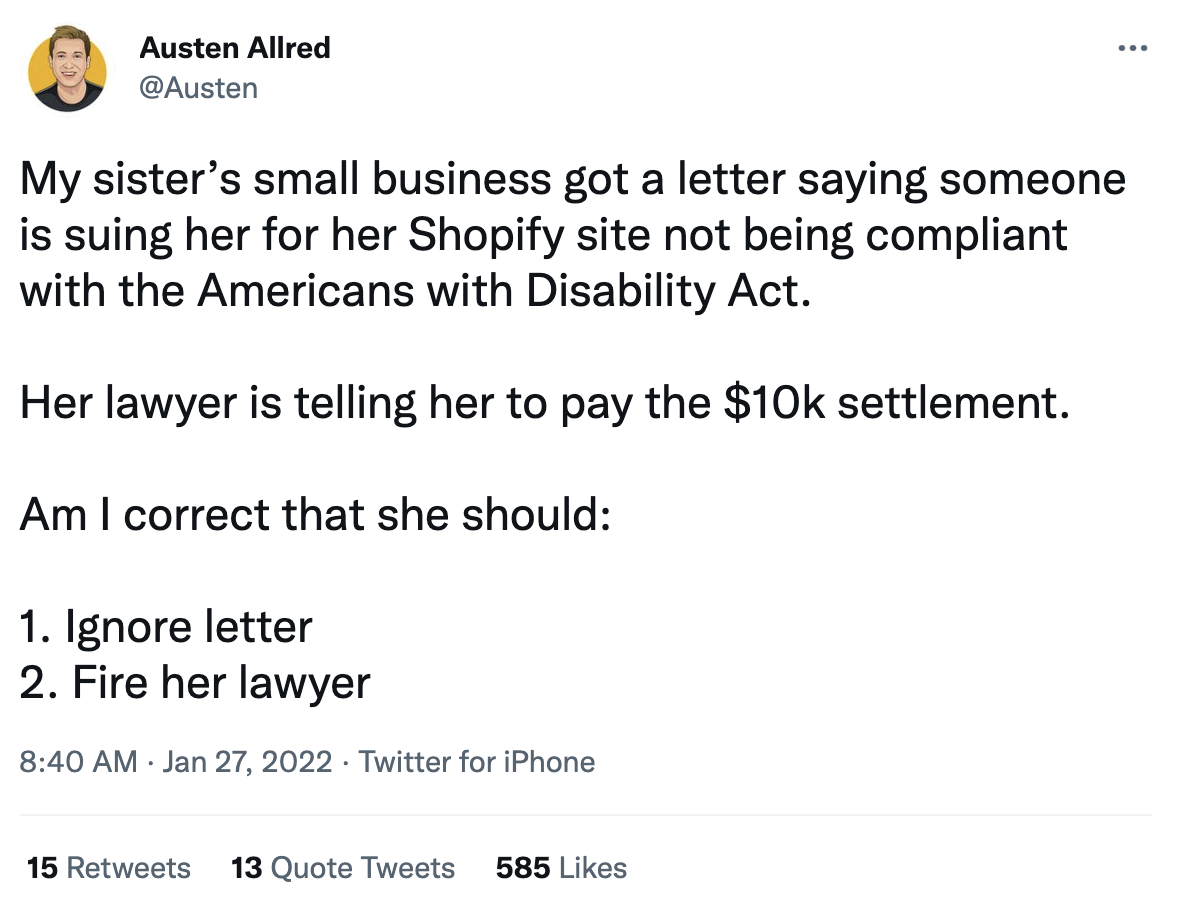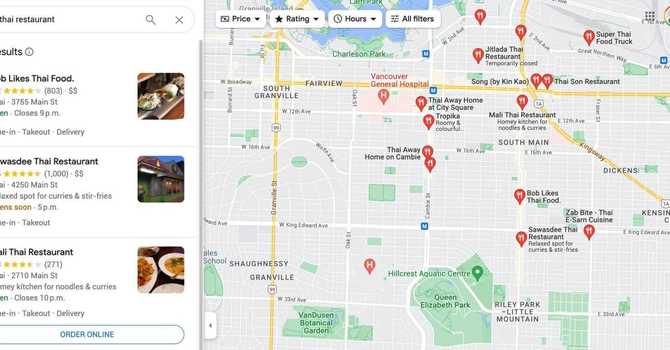
Web accessibility litigation for business websites that were restrictive to users with disabilities continued to grow in 2021.
You probably got the warnings across in your email inbox or social media feed. General trends show an increase in lawsuits filed in US federal and state courts.
You may not think it will happen to you, but in 2020 there were more than 2,500 ADA compliance lawsuits filed.
Consider this Tweet we saw today:

What Would You Do?
Working in the medical field means meeting a lot of strict legal guidelines, including ADA compliance on your website. ADA is short for the Americans with Disabilities Act – an act that strives to protect those with disabilities from discrimination – whether direct or indirect.
We were amazed while researching this topic how the US government chose not to create a government agency to enforce ADA laws (they did when it came to the Food and Drug Association upholding food standards). Instead, a decision was made to let the courts enforce ADA laws.
As a business owner, it's important to be ADA compliant with your website. Not only is it the morally right thing to do, it protects you from the threat of devastating litigation.
This means making sure that all of your content is accessible to everyone, including those who have disabilities.
What Is Website Accessibility For Small Businesses?
Website accessibility for those who are blind, deaf, or need to navigate by voice or other assistive technology. If what follows in this blog post seems confusing to you, don't get overwhelmed. We will have information at the end about how we can make sure that you're protected.
It doesn't help that there is a lot of gray area because there are no exact rules for what meets ADA compliance. Continue reading to learn about the top ways to make your website ADA compliant and protect yourself from a lawsuit or fines.
Understanding ADA Compliance And Your Small Business
As a small business, you likely have a diverse group of customers. Your website needs to be equally accessible to anyone. If a patient is blind and your website doesn’t have the appropriate accommodations, it can be considered discrimination.
You’re already meeting other ADA compliance requirements by providing handicap parking, braille on signs, and ramps for wheelchairs. Consider ADA website compliance for your business an extension of those requirements.
There are two business categories that require ADA compliance for websites. The first category is Title I businesses that operate at least 20 weeks per year with 15 or more full-time employees. The second is Title III businesses that are under the umbrella of "public accommodation."
What Does ADA Compliance for Websites Mean?
Federal law doesn’t outline specific website guidelines. It is generally accepted that a business must be able to prove that they make a good-faith effort toward accommodating people with disabilities. For this reason, documentation of website additions or changes is just as important as the changes you are making.
Many businesses strive to meet the Web Content Accessibility Guidelines (WCAG). The first introduction of WCAG happened in 1999. Experts have since updated the guidelines twice to reflect changes in technology. The three WCAG versions are 1.0, 2.0, and 2.1. According to the latest WCAG requirements, you must ensure that your website meets four key criteria.
1. Your Website Content Must be Perceivable
This means that a person must be able to understand the content no matter what type of accommodation they need. For example, you may provide an audio alternative to test fields so someone with a visual impairment can still understand your website. The text must also translate via other types of assistive technology in a way that makes sense to the user.
2. Your Website Must be Easy to Operate
When someone without an impairment visits your website, they can access menus and search tools to find what they need. These tools must be equally operable for someone with a disability. For example, there may be keyboard accessibility so that navigations items and intuitive for users that have assistive technology.
3. Your Website Must be Easy to Understand
If you have an image on your website that acts as a link to another page, the corresponding text should make sense for your users. Accessibility content needs to be as transparent as possible so that users understand how to navigate your site with ease. In some cases, you may need to offer input assistance for users.
4. Your Website Must be Versatile
There is a broad range of disabilities and impairments that require website accessibility. You cannot cater to one without offering compatibility to all. Your website content needs to easily translate across multiple types of assistive devices and platforms.
Levels Of Compliance
Based on our research, this is where "compliance" gets a little grey. Based on the above criteria, we know there are three levels of ADA Compliance. It starts with basic and advances to higher levels of accessibility.
- A – The website reflects the minimum accessibility requirements
- AA – The website meets legal requirements for accessibility
- AAA – The website exceeds requirements for accessibility
Since you cannot reference regulations or statutes to determine where your website falls within these three levels, you should research related cases. Look at cases where business owners have been sued for ADA compliance and read the outcome. If the website was deemed reasonably accessible, what features are outlined? If changes needed to be made, what were they?
Two Tips for Developing an ADA-Compliant Website
It may seem overwhelming at first to adjust your website to meet a vast range of needs. With these tips, you can quickly make your website ADA compliant. Keep in mind that your best strategy is to partner with a firm that has specific knowledge of ADA compliance.
1. Choose Your Advisors Wisely
Did you have your website built by a marketing company or a nephew who did you a favor? You want to connect with them to ensure that they fully understand ADA compliance. If not, you may be left paying a hefty fee for your project and still remain at risk for lawsuits.
At the end of the day, your business is liable should your site be deemed inaccessible.
When it comes to making your website ADA compliant, don’t cut corners. Questions to ask before signing on with an agency include:
- If they offer an ADA compliance guarantee
- How often they plan to make ADA updates to the website
- Request examples of ADA-compliant websites from their portfolio
The best thing about Get Clear websites is that at the core of the codebase they meet compliance requirements. We've built our platform with compliance in mind.
2. Avoid Quick-Fix Solutions
You want to make your website ADA compliant as quickly as possible and check the project off your list. There are website scanners that promise to show you what changes to make. There are also website overlays that promise to offer ADA compliance through a shortcut.
Installing a widget is a great step forward but there are other requirements mentioned in the next section that should also be taken into consideration.
You don't want to cut corners when it comes to protecting your website from litigation. Would you cut corners installing a wheelchair ramp or creating braille signage? No. So you don’t want to cut corners on your website, either.
Key Elements Of Your Website You Need To Update
As a business owner, you want to be knowledgeable whether you plan to do the work through an in-house expert or meet with a vendor or partner. Having a basic understanding of ADA compliance and website language helps you know what questions to ask and what to look for.
Included below are the key elements that every website needs to address. Keep in mind that each website is unique, and you may need to make other changes in addition to these.
- Write out detailed alt tags (alternative tags) for all images, videos, and audio files present on your website. If your user cannot see or hear, these alt tags provide valuable information about your website. You should describe the image or video and explain its importance or purpose for your site.
- If you have a video or audio file, take it one step further and offer a word-for-word transcript alternative. This way someone with a disability has access to the same information as anyone else.
- Make tweaks to your website’s header code. This code outlines the primary language used on your website and helps users that have text readers. Tools like text readers rely on header codes to navigate your website smoothly.
- You should also include alternative suggestions if a user encounters an error. Even when you make your best effort to create an ADA-compliant website, things can go wrong. Inevitably, someone along the way will come across an error message.
- Ensure that error messages are detailed and offer your users with alternative navigation options. You may even consider listing a contact for ADA error tags. Then, users can share their experience and you can improve your website even more.
- Keep your website layout simple. This is true with and without ADA compliance. A simple website is easier to navigate no matter who your users are. Plus, a simple design makes ADA compliance easier to manage. A complicated website leaves you at risk for missing details and offering a bad user experience.
Risks of Not Complying with ADA Requirements
If your website is not ADA compliant, you’re at a risk for lawsuits and fines. Depending on your business location, an ADA lawsuit may cost you up to $50,000. This doesn’t include the cost of making the appropriate changes to your site.
Aside from financial risks, you may also face risks of losing business. Google and other search engines give higher rankings to websites that are easy to navigate. This includes ADA-compliant navigation. If you don’t rank high enough in search results, potential customers may not ever see your website.
Additionally, people with disabilities may leave your site and visit another website if they cannot navigate to find what they need. Over time, these lost opportunities add up and cost your business in lost revenue.
Get Clear Sites Is Here To Help (You Sleep At Night)
Thankfully, our team has known about website accessibility for many years. We built our proprietary platform with compliance in mind. The pages are organized right down to the base level coding to be compliant at a base level.
Our more advanced compliance packages offer you next-level compliance coverage with a widget, an accessibility statement and the behind the scenes upgrades to accommodate all the customizations you've added to your site.
If you want to make sure you're protected from litigation, please don't hesitate to contact us and talk about it.
Get Compliant Today. Contact Our Team
- If you would like to learn more about what we can do to get your website compliant with ADA standards, check out this page.
- If you'd rather schedule a call with someone on our team, don't hesitate to schedule a call today. Click here to book a call.




